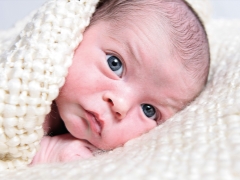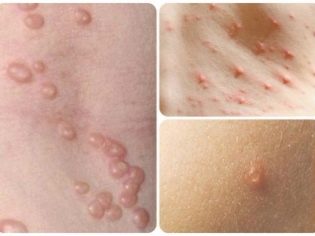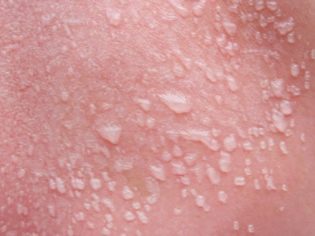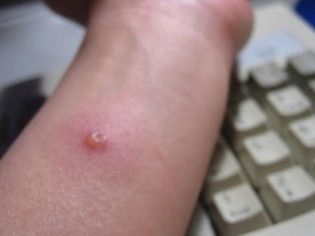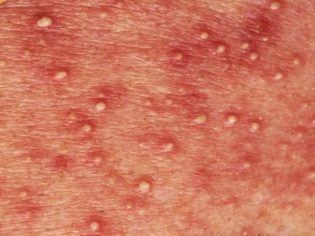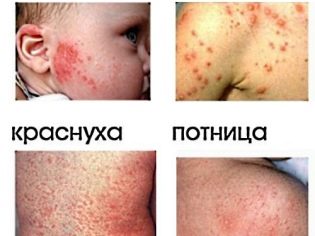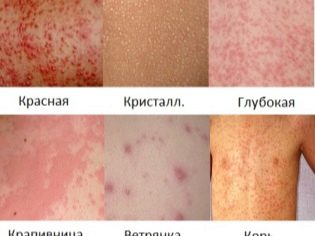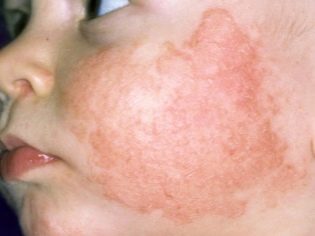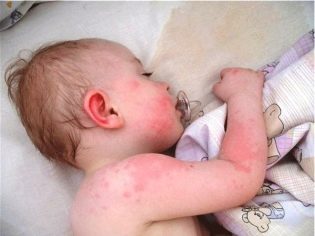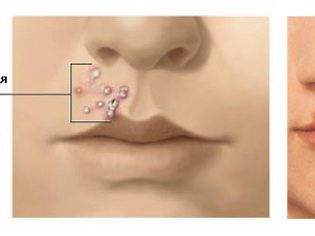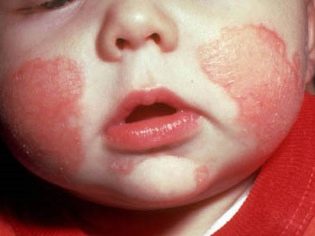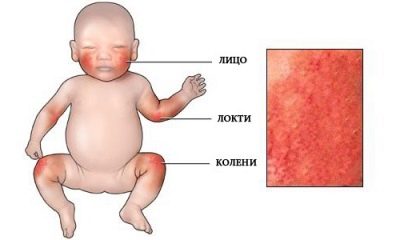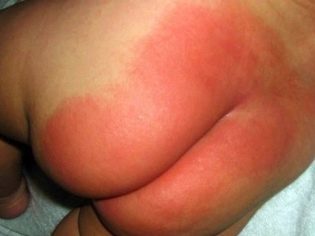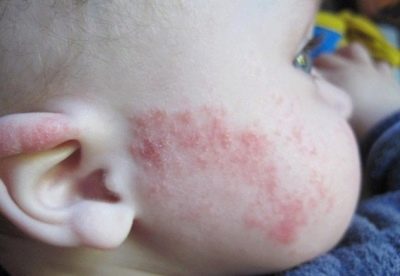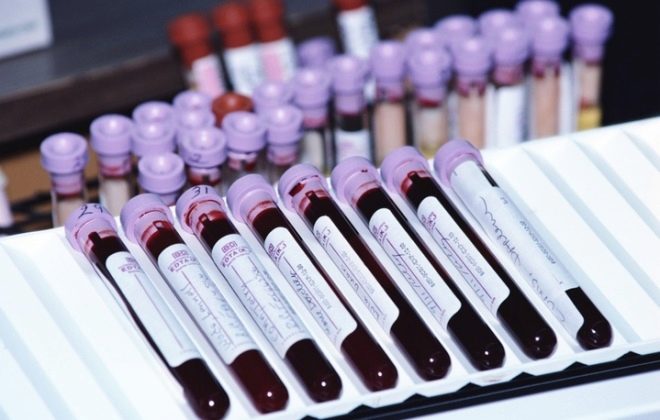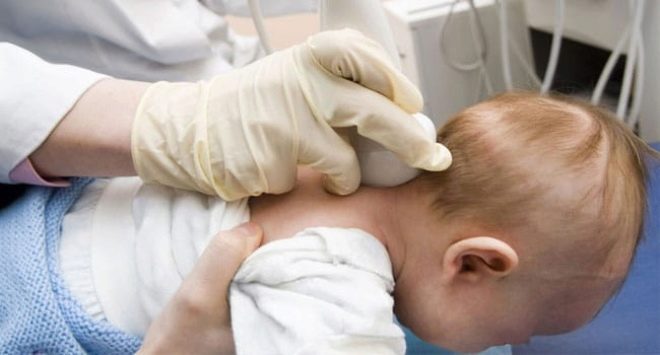Why does watery acne appear on the baby’s body?
Skin rashes in babies are found for a variety of reasons. The appearance of watery acne on the body is an adverse symptom that can occur in a wide variety of pathologies.
This article will help you learn more about what parents should do when a skin rash appears in a child.
Causes of
Water acne on the body can appear in babies of the first years of life, and in adolescents. They arise as a result of exposure to a variety of reasons.
Such skin rashes look like bubbles containing fluid inside. The contents of watery bubbles may vary. Usually it is a serous fluid or blood with an admixture of blood.
With some bacterial pathologies of the skin, pus begins to appear inside the bubbles. This symptom is already extremely unfavorable and indicates a secondary infection.
Purulent content can be seen from the side. In this case, the color of the liquid inside the bubble changes. It becomes yellow or with a green tint.
In babies, watery bubbles on the skin appear much more often than in adults. This feature is due to the physiological structure of the skin layers in young children.
The imperfection of local immunity contributes to the spread of watery bubbles throughout the body in a relatively short period of time. The size of these skin rashes may be different and depends on what contributes to their appearance.
The following causes can cause the appearance of watery bubbles on the skin of babies:
- allergic reactions;
- pemphigus;
- contact and diaper dermatitis;
- impetigo staphylococcal etiology;
- childhood infections;
- prickly heat, hyperhidrosis;
- eczema;
- contagious molluscum infection;
- infection herpes;
- infectious viral and bacterial infections;
- scabies;
- diseases of the endocrine system and chronic diseases of internal organs.
Quite often, watery pimples are accompanied by the appearance on the skin and other symptoms. These include: increased dryness of the skin, severe redness, inflammation and the appearance of numerous dense dry crusts.
The severity of adverse symptoms may be different. The duration of the preservation of skin rash is influenced by many factors: the child’s age, the presence of concomitant pathologies of internal organs, the level of functioning of the child’s immunity.
Features of rash in some diseases
Pemphigus
In infants, quite often the cause of the appearance on the skin of various bubbles filled with fluid is a disease called pemphigus. According to statistics, the peak of the development of this pathological condition occurs in the newborn age.
This pathology can occur in both benign and malignant forms. An adverse version of the disease is also called ritter's exfoliative dermatitis.
A baby can become infected with this skin disease during medical procedures that are conducted in violation of hygiene rules, or from a mother who has some kind of purulent pathology.
Massive cases of infection occur when babies are infected at the hands of medical professionals. A specific clinical sign of this skin pathology is the appearance of numerous vesicles on the skin of an infected child.
They are usually quite small in size and are located on the body in groups. The skin around these lesions becomes bright red. In some cases, it becomes hot to the touch.
Inside the bubbles is a large amount of serous fluid. In severe cases, already purulent formations appear.
Preferential localization - on the abdomen or near the navel, on the legs, and also in the skin folds. Over time, these skin rashes disappear.
Residual symptoms usually appear in depigmented skin areas, which also disappear within a few weeks. In some babies, such bubbles may appear on the oral mucosa.
Chickenpox
“Chickenpox” is another fairly common cause of the appearance of various skin rashes on a child’s skin. As a rule, they look like numerous watery bubbles.
The fluid component in them is a serous turbid fluid. For chickenpox is characterized by a rather severe course, accompanied by fever and severe symptoms of intoxication.
Bubbles on the skin with this child infection appear gradually. A few days after the onset of the disease, they almost cover the entire surface of the body.
Watery bubbles can be seen on the back, on the hands, face, legs of the baby. In some cases, they may burst, and the liquid contained in them will flow out. The appearance of such skin elements may be accompanied by the development of a strong itch in a sick child.
Toddlers attending children's educational institutions are more susceptible to infection with this infection. Only timely vaccination will help protect a child from infection with this infectious disease.
Chickenpox is a quarantine disease. The peak incidence occurs at the age of 2-6 years.
Diaper dermatitis
This pathological condition occurs in newborn babies and children of a very early age. The name of the disease is the cause that causes these symptoms in the smallest patients.
Wearing diapers leads to the appearance of watery bubbles in the child's priest. Direct contact of the perineum of the baby with the absorbent diaper layer leads to the development of contact allergic inflammation, manifested by the appearance of numerous skin rashes on the skin.
For quite a long time, this pathological condition in children was called diaper rash. The use of this term to denote the essence of the disease is also possible.
The prevalence of this pathology in children is quite high. According to statistics, every second newborn baby during the first year of life may experience this pathological condition.
This pathology manifests itself on the skin by the appearance of multiple watery blisters. Usually they are located on the inflamed areas of the skin.
Affected skin acquires a bright red color, there is a strong weeping. Prolonged inflammation leads to the development of edema of surrounding tissues.
Streptoderma
This pathology arises as a result of infection with various types of streptococci and is characterized by the development of numerous bubbles on the skin, filled inside with a gray or pinkish liquid.
Streptoderma is a fairly common pathology in children. This disease is contagious.
A healthy baby can become infected from a patient. Watery bubbles can occur at the same time on the most different skin areas. Quite often they appear between the fingers, on the palms, on the stomach.
Often sick children and toddlers with immunodeficiency states are much more susceptible to streptoderma than children with strong immunity.
As the disease progresses, the color of the fluid inside the skin rash also changes. At first it has a gray tint, then it may turn yellowish or green.This color change is a very unfavorable symptom and indicates the progression of the disease.
Over time, these watery bubbles burst, and the liquid flows out. Inadequate hygiene can lead to the development of dangerous complications.
True eczema
This pathology refers to dermatosis. It is accompanied by the development of numerous bubbles on the skin that itch severely. After opening the skin rash eroded areas remain.
This period of the disease is one of the worst. Microbes and bacteria that contribute to secondary infection of the wound can get into erosion.
The earliest manifestation of the disease is redness and swelling of the affected area. After a few days, bubbles appear inside the inflamed skin, filled with bloody fluid inside. They can be of various sizes.
The development of eczema often leads to exposure to chemicals, as well as a pronounced decrease in immunity and exacerbation of chronic diseases of internal organs.
After the disappearance of bubbles with eczema, dense crusts remain on the skin, which are gradually exfoliated. The centers of skin rashes are usually located in groups and have a tendency to merge.
The state of health of the child significantly worsens the pronounced skin itching, which often accompanies the appearance of numerous bubbles on the skin.
In some immunodeficient states, eczema can become chronic. In this case, requires the appointment and conduct of complex treatment. It is not only necessary for the elimination of adverse symptoms, but also for the prevention of new exacerbations of the disease in the future.
What to do when they appear?
If a baby has got various watery pimples on the skin, you should immediately consult a doctor. To establish the cause of the disease, quite often it is necessary to conduct a whole complex of diagnostics, which includes a variety of methods.
Such an examination is necessary, since there are quite a lot of diseases that occur with the development of watery pimples on the skin.
To establish the correct diagnosis to the baby, the following laboratory tests and studies are conducted:
- General analysis of blood and urine. They help identify viral or bacterial infections in the child’s body, as well as the degree of functional impairment.
- Biochemical study of blood. Necessary to determine the work of the internal organs. Functional disorders of the liver, kidneys, gallbladder are well defined using this method.
- Seeding of detachable. Biological material for this becomes the liquid obtained from the bubbles. Bakposev allows you to determine the exact cause of the disease, which caused the appearance of rashes on the skin.
- Conducting allergy tests. This study is conducted with any suspicion of the presence of allergies in the child. Conducted such a laboratory test in a child immunologist.
- Clinical examination of the skin. This study is conducted by a pediatric dermatologist. During the examination, the doctor identifies specific signs of a wide variety of dermatological pathologies, which manifest with the development of watery pimples on the skin. In complex clinical cases, a specialist will recommend consulting with other doctors if the cause of the disease is any chronic disease of the internal organs. Some infectious pathologies are treated by an infectious disease specialist.
- Dermatoscopy. This examination is conducted by a pediatric dermatologist with a special device. This study helps to examine all skin layers in a more thorough manner. Dermatoscopy is also performed for the differential diagnosis of many dermatological pathologies.
Treatment is prescribed individually, taking into account the cause, which influenced the development of these adverse symptoms.
For the treatment of bacterial eruptions are used modern groups of antibiotics, with a fairly wide range of actions. The duration of the course of treatment is determined by the attending physician, taking into account the age of the baby and the presence of chronic associated pathologies.
Allergic forms of dermatosis are treated with antihistamine and anti-inflammatory drugs.
Why does watery acne appear on the baby’s body? Doctor will tell about child rash Komarovsky.
